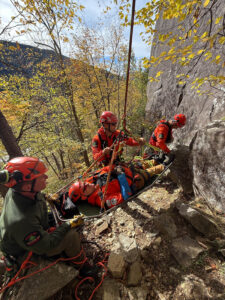DEC releases report on Goodman Mountain moose
Suffered severe emmaciation, underlying cause unknown

The moose that was ultimately euthanized after showing severe emaciation and abnormal behavior is seen near the summit of Goodman Mountain in June. (Provided photo — Joanne Kennedy)
TUPPER LAKE — The state Department of Environmental Conservation recently released its necropsy results from a moose that was euthanized on Aug. 6. The moose had appeared sick and was acting abnormally, lingering around the Goodman Mountain summit area for about three months.
The results confirmed that the moose was in severe physical deterioration, likely as a result of brain lesions and inflammation — but failed to identify an underlying cause of those.
The approximately 3-year-old male moose “suffered from a chronic condition” that rendered it emaciated and unable to navigate effectively, according to the report. The moose had microscopic lesions as well as active brain inflammation. There was also scar tissue between the moose’s organs in its abdominal and thoracic cavities, indicating either previous or ongoing inflammation or infection there.
Despite “extensive testing,” wildlife experts were unable to pinpoint a specific bacteria, virus or other cause for the moose’s declining health. The report noted that next-generation sequencing for viral DNA on the moose’s brain tissue failed to identify any “relevant sequences,” and that virus isolation and testing of the culture of the spleen did not yield any culprits.
“No conclusive cause was identified by ancillary testing for the lesions in the brain,” the report noted. “But these lesions likely contributed to the behavior and decline of this moose.”
Several common causes of moose deaths throughout the region were, however, ruled out. The report eliminated brainworm as a cause of the moose’s condition — noting that there were “thorough” dissections of the brain and spinal cord regions in an effort to find evidence of the parasite roundworm. There were lesions associated with liver fluke, a parasitic flatworm, though the report noted that the damage was not “extensive” compared to what would be expected for a moose in New York, and wouldn’t have accounted for the moose’s condition.
There was also testing that ruled out other pathogens, including rabies, avian flu, West Nile virus, epizootic hemorrhagic disease, Eastern equine encephalitis, bovine viral diarrhea, Francisella tularensis and Yersinia pestis. Chronic Wasting Disease was also tested for and not detected, according to the report. Pituitary and middle ear disease were also ruled out.
The report notes that other viral diseases not found in testing could be responsible for the inflammation and brain lesions that are thought to have led to the moose’s decline.
The moose appeared to suffer earlier unrelated traumatic injury — not including the euthanization, which was a gunshot wound to the heart — indicated by a healed rib fracture and a granuloma in the abdominal cavity, but there was no indication that these contributed to the moose’s poor health prior to its euthanization.
The necropsy found the moose to be in poor physical condition when it was euthanized. It noted that the carcass was emaciated “with markedly prominent ribs, spine and hip bones” and had little subcutaneous and visceral fat. The moose’s bone marrow was also in poor condition and the report found that the fat cells there were depleted.
The moose was first reported by Goodman Mountain hikers in early May, with the DEC closing the trail on June 6 after the moose appeared to be entrenched around Goodman’s summit area. It showed few signs of moving, despite several attempts by wildlife officials to deter it from the area. Trail cameras were set up
to observe the moose, with an observed head tilt and a continued decline in its health. After the moose was euthanized, wildlife officials conducted further field samples and documented signs of its foraging behavior before the trail was reopened on Aug. 22.
The report was dated Oct. 22 and completed by the DEC’s Wildlife Health Unit, wildlife biologists and researchers at Cornell University’s Wildlife Health Lab, with some testing being performed at the state Department of Health’s Wadsworth Center Bacteriology Laboratory and the University of Tennessee’s Department of Biomedical and Diagnostic Sciences.




